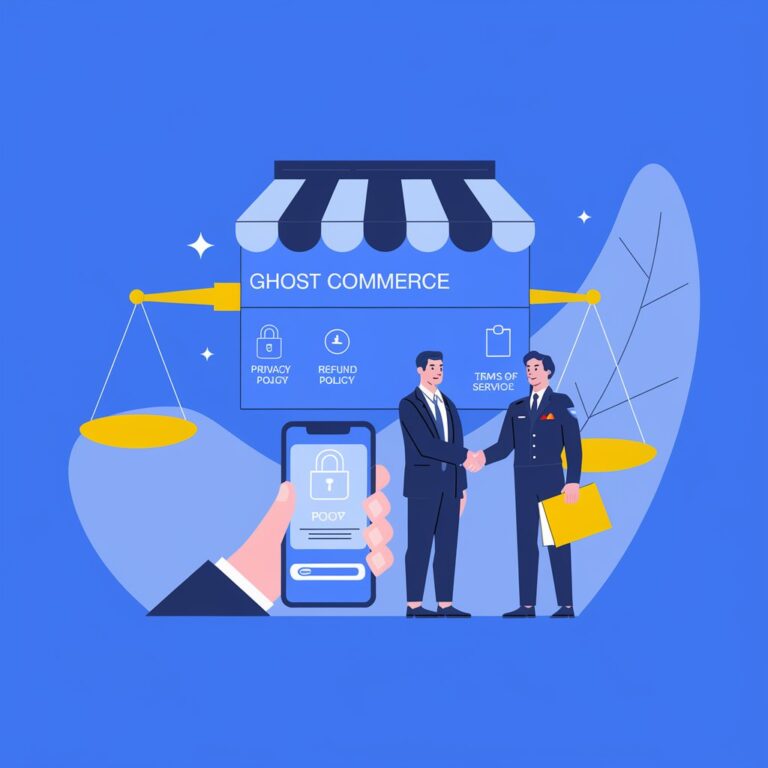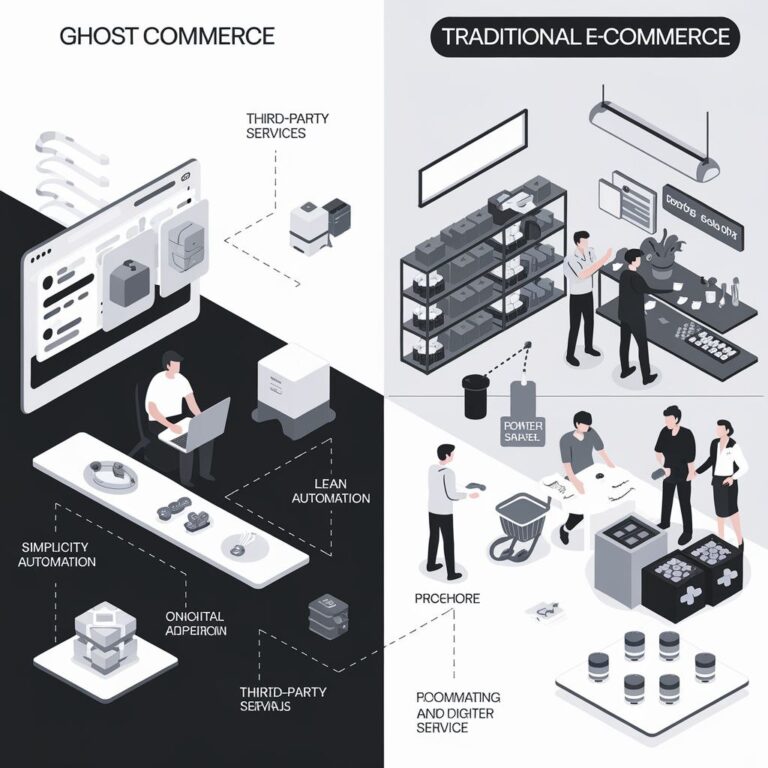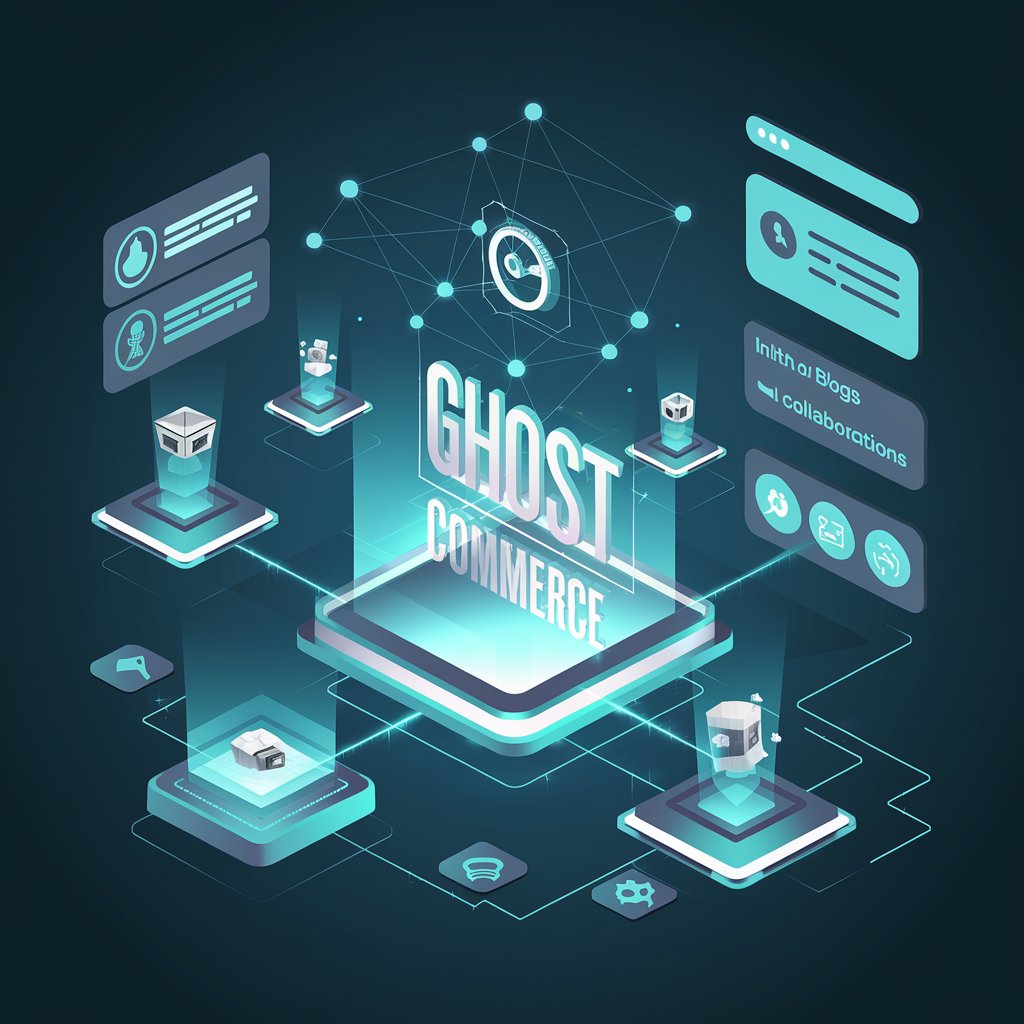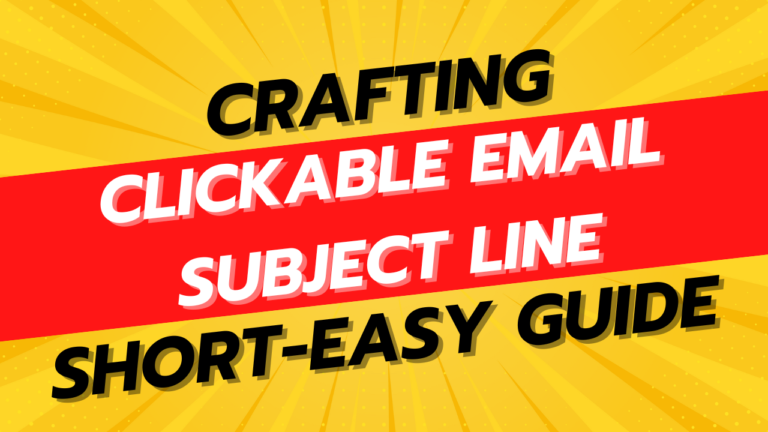Ghost commerce: the definitive guide (2025)
what is ghost commerce?
Ghost commerce is a modern online business model that reevaluate how products are marketed and sold by eliminating the need for physical inventory or a traditional online store.
Instead of managing stock or shipping products, particulars or businesses use their online influence to connect audiences with third-party retailers or eCommerce platforms.
This method depend heavily on digital channels such as social media, blogs, and influencer collaborations to drive traffic and encourage purchases. By acting as a bridge between buyers and retailers, ghost commerce smooth the process, allowing the promoter to focus on building an engaged audience and crafting compelling content.
The absence of inventory management significantly reduces overhead costs, making this model accessible to a wide range of entrepreneurs.
Whether through affiliate marketing, product reviews, or curated recommendations, ghost commerce enables individuals to monetize their platforms without the complexities of traditional retail.
This creative approach is particularly appealing in today’s digital landscape, where trust and authenticity drive purchasing decisions.
As more people turn to online platforms for inspiration and advice, ghost commerce continues to grow, offering a flexible and scalable way to earn income while connecting consumers with products they’ll love.
how does ghost commerce work?
Ghost commerce works by leveraging digital platforms to connect consumers with products without the need for managing inventory or handling logistics.
The process starts with the promoter, who uses their online presence—whether through social media, a blog, or another content-driven platform—to showcase or recommend products.
When a consumer is influenced to make a purchase, the transaction is handled entirely by the third-party retailer or eCommerce platform. This eliminates the need for the promoter to store, ship, or manage the product directly.
The promoter earns a commission or fee for driving sales, creating a seamless and low-cost entry point into online business. By focusing on audience engagement and strategic content, ghost commerce offers an accessible and scalable way to generate income.
This model thrives on trust, authenticity, and digital reach, making it an appealing option for those looking to monetize their online influence effectively and sustainably.
is ghost commerce legit?

Ghost commerce is a legitimate business model and fully legal when operated responsibly.
To avoid potential issues, focus on ethical practices. Partner with reputable suppliers to ensure smooth operations and transparency in your business dealings.
Avoid selling illegal, dangerous, or age-restricted products to maintain compliance with laws and regulations.
Incorporating essential legal pages like a privacy policy, refund policy, and returns policy on your store enhances customer trust and protects your business.
By adhering to these principles, ghost commerce can thrive without legal challenges, offering a sustainable way to succeed online.
Prioritizing ethical sourcing, transparency, and clear policies not only ensures legitimacy but also builds a strong foundation for long-term growth.
Ghost commerce is a promising opportunity, provided you stay committed to responsible practices and customer satisfaction.
Ghost commerce vs Ecommerce

G commerce and e-commerce are both exciting opportunities for entrepreneurs looking to tap into the online market, but their approaches differ significantly. G commerce, often called the leaner cousin of e-commerce, offers an accessible and cost-effective way to enter the digital marketplace.
Unlike traditional e-commerce, G commerce relies on third-party services for product manufacturing, storage, and shipping, enabling entrepreneurs to avoid the complexities of inventory management and logistics.
This approach makes it ideal for those with limited experience or resources, offering a fast and low-risk pathway to starting a business.
In contrast, e-commerce often requires a higher initial investment, as it involves managing every aspect of the business, including branding, customer service, and product quality control.
Entrepreneurs who choose e-commerce typically aim to build a recognizable brand and cultivate customer loyalty. This model allows for greater control over the entire process but comes with higher financial and operational demands.
One key factor to consider is budget. G commerce is perfect for those starting with minimal capital, as it eliminates the need for large upfront costs. By outsourcing operational aspects, business owners can focus on marketing and sales. On the other hand, e-commerce requires a more significant financial commitment to develop infrastructure, hire staff, and manage day-to-day operations.
Experience also plays a crucial role in deciding between the two models.
G commerce is beginner-friendly, requiring minimal expertise to get started. Automation tools further simplify the process, making it an excellent option for first-time entrepreneurs.
E-commerce, however, demands more experience and a deeper understanding of managing complex business operations, which might not be suitable for everyone starting fresh.
Targeting the right niche is another critical aspect. G commerce allows flexibility in testing different markets and products without significant risk. This model works particularly well for customizable or trending products that don’t require rigorous quality control.
E-commerce, in contrast, may be better suited for specialized niches that demand expertise and high-quality standards, enabling the creation of a loyal customer base over time.
Clarifying objectives is essential when choosing between G commerce and e-commerce. If the goal is to build a scalable, recognizable brand with a loyal customer following, e-commerce is the better choice.
However, if the priority is quick revenue generation and minimal overhead, G commerce offers an appealing solution. This model’s streamlined nature allows entrepreneurs to scale operations quickly while minimizing risks.
In summary, G commerce emphasizes efficiency, affordability, and ease of entry, making it ideal for those seeking a flexible and low-risk approach.
Traditional e-commerce, while demanding more resources and effort, provides opportunities to build a robust brand with long-term growth potential. Both models can lead to success, depending on your goals, budget, and level of expertise.
Ghost Commerce Pros and Cons

Ghost commerce is an innovative business model offering a simple and affordable way to enter the digital marketplace.
Its biggest advantage is the low startup cost, making it accessible to entrepreneurs with limited budgets. By outsourcing production, storage, and shipping to third-party suppliers, ghost commerce eliminates the need for physical inventory management.
This allows entrepreneurs to focus on marketing and scaling their business without dealing with logistical challenges. Additionally, automation tools make operations easier, saving time and reducing the need for extensive experience.
However, ghost commerce has its challenges. Relying on third-party suppliers means less control over product quality and shipping times. If issues arise, it may negatively affect customer satisfaction and reputation.
Profit margins can also be lower compared to traditional e-commerce models, depending on the supplier and product niche.
Despite these drawbacks, ghost commerce remains an attractive option for many entrepreneurs due to its flexibility and low financial risk.
Pros of Ghost Commerce:
- Requires minimal initial investment, reducing financial risk.
- No need for physical inventory or supply chain management.
- Allows focus on marketing and business growth.
- Easy to start with little to no experience.
- Provides flexibility to explore various niches and products.
Cons of Ghost Commerce:
- Limited control over product quality and shipping times.
- Relies heavily on third-party suppliers.
- Lower profit margins in some cases.
- Potential risks of supplier mismanagement or delays.
Ghost commerce is ideal for those seeking a low-risk, scalable way to start an online business. While it has some limitations, its benefits often outweigh the challenges, especially for entrepreneurs who prioritize efficiency and affordability.
With the right strategy and reliable suppliers, ghost commerce offers a promising pathway to online business success.
Ghost commerce: Ultimate Step by Step
Step 1: Select Your Niche

The first step in ghost commerce is selecting the niche you want to focus on. Choose a product or industry that interests you and matches your knowledge or expertise.
A niche helps you stand out in the crowded online marketplace and targets a specific audience. Think about the problems your chosen products solve and the audience they serve.
For example, if you are passionate about eco-friendly products, focus on items like reusable household goods or biodegradable packaging. Research market demand to ensure your niche has an audience willing to buy.
Identifying trends, exploring your competitors, and narrowing down to a specific customer segment will increase your chances of success.
A well-defined niche ensures your marketing and product strategies are focused and effective.
Step 2: Set Up Your Online Store

Once you’ve defined your niche, set up your online presence. Use an eCommerce platform like Shopify, Wix, or WooCommerce to create your store.
Choose a template that aligns with your brand identity and customize it for a professional look. Include essential features like easy navigation, a search bar, and secure payment options to create a seamless shopping experience. Add sections such as an About Us page and FAQs to establish trust.
Make your website mobile-friendly since many shoppers browse and buy from their phones. Implement SEO best practices like using relevant keywords, meta descriptions, and optimized images to attract organic traffic.
With a visually appealing and functional website, you’ll have a solid foundation to grow your ghost commerce business.
Step 3: Choose Your Supplier
In ghost commerce, the supplier is a critical partner. Research and connect with reputable suppliers who offer dropshipping services.
Evaluate their product catalog, shipping times, and customer service responsiveness. Platforms like AliExpress, Spocket, and Oberlo can help you find reliable suppliers. Ensure they have a good track record and offer quality products that match your niche.
Request product samples to assess quality before listing them on your store. Building a strong partnership with a supplier ensures smooth order fulfillment and a positive customer experience.
Step 4: Add Products and Promote
After finalizing your supplier, list their products on your online store. Customize product descriptions to highlight benefits and features, making them appealing to your audience. Use high-quality images or videos to showcase products visually.
Set competitive prices while accounting for shipping costs and your profit margin. Once your product listings are complete, focus on promotion. Leverage social media platforms like Instagram and TikTok to run campaigns or collaborate with influencers.
Use email marketing to engage with your audience, offering discounts or updates on new arrivals.
Paid advertising through platforms like Facebook Ads can also drive traffic to your store.
Step 5: Process Customer Orders and Fulfillment
When customers place orders, your online store collects details like shipping addresses and payment information.
This data is stored in your website’s system and allows you to process transactions efficiently.
Ensuring a smooth checkout process builds trust and encourages repeat purchases.
Step 6: Forward Orders to Suppliers
Once an order is received, forward it to your supplier for processing. Many eCommerce platforms allow integration with suppliers, automating this step.
The supplier receives the customer’s details and begins preparing the order. Monitor orders to ensure everything is on track for timely delivery.
Step 7: Supplier Order Fulfillment
Your supplier handles the entire fulfillment process, including packaging and shipping the product directly to your customer.
They generate shipping labels and manage any necessary customs paperwork for international orders. A reliable supplier ensures your customer gets their purchase quickly and in good condition.
Step 8: Deliver to Customers

Customers receive their orders as if they were shipped directly from your store. Depending on your agreement, packaging may include your branding or remain neutral.
Delivering on time and meeting customer expectations builds trust and encourages positive reviews.
Step 9: Manage Payments
When customers pay, you collect the full retail price via your website’s payment system. You then pay the supplier the wholesale price of the product, keeping the difference as your profit.
Use secure and trusted payment gateways to handle transactions and minimize disputes.
Step 10: Provide Customer Support
Customer service is key in ghost commerce. Address inquiries promptly, handle complaints professionally, and resolve issues like refunds or returns. Communicate with your supplier to resolve order-related concerns quickly. Providing excellent support creates loyal customers and strengthens your brand reputation.
With these steps, your ghost commerce business can operate smoothly, offering a scalable and low-risk entry into the eCommerce world.
How to Develop an Effective Ghost Commerce Strategy?
Build a Powerful Online Presence:
Creating a strong online presence is essential for the success of any ghost commerce business. Start by building a user-friendly website that is visually appealing and easy to navigate.
A well-designed eCommerce site keeps visitors engaged and encourages them to explore your products. Share high-quality content across your website and social media platforms to increase visibility and connect with your target audience.
Engaging content, like blog posts, videos, and interactive features, builds trust and fosters a sense of community.
Consistent branding across all channels reinforces your identity and makes your business memorable. Utilize social media to interact with your audience, answer questions, and promote your products.
By maintaining a cohesive and professional online presence, you can attract potential customers, enhance your reputation, and build lasting relationships with your audience.
Prioritize the Customer Experience
Prioritizing customer experience is essential for the success of your ghost commerce business. Provide excellent service that exceeds expectations, setting your store apart from competitors.
Ensure products are delivered reliably and on time to build trust with your audience. Offer a flexible and clear return policy to give customers confidence in their purchases.
Be responsive to inquiries and address concerns promptly, showing your commitment to their satisfaction.
A positive shopping experience encourages repeat purchases and fosters loyalty. Happy customers are more likely to recommend your store to others, expanding your reach and enhancing your reputation.
By focusing on every aspect of the customer journey, you can create lasting relationships and position your ghost commerce business as a trusted and customer-centric brand.
Utilize Data Analytics for Business Growth
In ghost commerce, leveraging data analytics is crucial to growing your business. Use web analytics to monitor customer behavior and preferences.
This data helps you tailor your product offerings and marketing strategies to meet customer needs. By tracking trends, you can identify what products perform well and adjust accordingly.
Optimizing your website based on data insights improves conversion rates and enhances user experience. Analyzing customer interactions allows you to make informed decisions that drive sales and increase customer satisfaction.
Regularly reviewing key metrics ensures you stay ahead of market trends and adjust to changes swiftly. By effectively utilizing data analytics, you can refine your ghost commerce strategies for continuous growth and success.
Partner with Influencers for Growth
Collaborating with influencers is a powerful strategy for your ghost commerce business. Partnering with influential figures in your niche boosts brand visibility and credibility.
Influencer marketing can drive traffic to your website and increase sales. Choose influencers who align with your brand values and target audience.
Their strong and engaged following will help create authentic connections with potential customers.
By working with the right influencers, you can reach a wider audience and build trust quickly. Their endorsements and promotions lend authority to your brand, encouraging more people to explore your products.
Influencer partnerships are an effective way to enhance brand awareness, improve marketing efforts, and generate meaningful results for your ghost commerce business.
Enhance Your SEO for Better Visibility
Optimizing for SEO is crucial in growing your ghost commerce business. Ensure your website and content are search engine-friendly to increase visibility.
Use relevant keywords throughout your site to attract potential customers. Create high-quality, informative content that resonates with your target audience and answers their questions.
Don’t forget to optimize your meta descriptions and tags, making your pages more discoverable. By improving these elements, you increase your chances of ranking higher in search engine results pages.
This helps drive organic traffic to your site, bringing in more visitors without the need for paid ads. SEO optimization enhances the user experience while boosting your credibility, making it an essential strategy for long-term success in ghost commerce.
Leverage Email Marketing for Growth
Email marketing is a powerful tool for your ghost commerce business. It helps you connect with both potential and existing customers.
Use targeted promotions, personalized product recommendations, and tailored content to engage your subscribers. Offering value through exclusive deals or valuable content encourages more people to sign up for your newsletter.
Incentives like complimentary downloads or special discount codes can increase your subscriber base and boost loyalty.
Email marketing allows you to nurture customer relationships and guide them toward making a purchase. By regularly sending relevant and engaging content, you build trust and keep your brand top-of-mind.
This strategy is cost-effective and can lead to higher conversion rates, making email marketing an essential part of your ghost commerce growth plan.
Ghost Commerce (Conclusion)
Ghost commerce has rapidly emerged as a popular business strategy, gaining traction in recent years.
The growth of creative economies and eCommerce platforms has raised awareness of “middlemen” who help facilitate digital transactions. In ghost commerce, these intermediaries play a crucial role in connecting manufacturers and retailers with a broader audience.
As we look ahead to ghost commerce in 2025, the model continues to evolve, providing opportunities for businesses to scale without the need for significant upfront investments.
By minimizing operational costs and focusing on marketing and customer engagement, ghost commerce allows businesses to thrive in a competitive digital landscape.
This strategy empowers entrepreneurs to tap into new markets and reach customers globally, making it an increasingly viable business model for the future.

